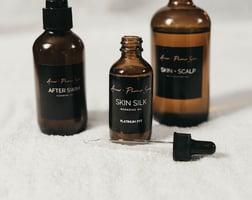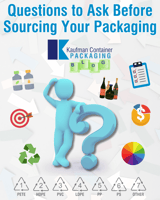Product packaging is both the first and last thing that consumers see throughout buying and using a...
Skincare Packaging Basics: Choosing the Right Material for Your Product
One of the most important considerations when selecting skincare product packaging is the material. With so many options to choose from, several factors need to be considered including appearance, durability and sustainability. Here are a few guidelines to help you choose the right packaging material.
Know Your Ingredients 
One issue many brands experience is having to reformulate their product due to a negative reaction with a certain packaging material. If your product and the container aren’t compatible, you will run into numerous quality issues such as leaks or contamination. Launching a defective package can also damage a product’s reputation in the market with both the consumer and the retail outlet. However, by understanding your ingredients and choosing the right type of material, you can reduce costs, maximize shelf life and maintain a positive brand image.
Aesthetics, Durability, and Functionality
The best packaging materials should appeal to the customer as well as keep the skincare products safe throughout its shelf life. The packaging material should also be strong and durable enough to protect the product from external factors such as heat and moisture. Think about how you want the customer to experience your product both in a retail setting and online.
Compare Different Packaging Materials
Here are some of the most common materials for packaging skincare products.
- Glass: Glass is one of the oldest and most popular packaging options for the beauty and personal care industry. Clear or ‘Flint” glass is used frequently for the fragrance industry and is still considered a very eco-friendly packaging solution. The upscale look and feel gives the consumers a positive experience. Amber-colored glass containers are ideal for essential oils and products where exposure to sunlight can affect the ingredients. However, one drawback is the brittle nature of glass, which can lead to breakage if a jar or bottle falls onto a hard surface.
- Polyethylene Terephthalate (PET/PETE): PET plastic is a great alternative to glass as it still provides the crystal clear appearance. It is much lighter than glass and consumers can easily use your product on the go. PET plastic is not reactive and provides a solid barrier against foreign materials that can affect the skincare product. With numerous stock options available, PET is one of the go-to packaging materials.
- High-Density Polyethylene (HDPE): HDPE plastic is ideal for skincare product packaging due to its durability, strength and high resistance to most acids. Readily available in the market, HDPE is an affordable option for start-up companies. Boston Rounds and Cylinders are a few stock options we offer and can be screen printed in-house by Kaufman Container.
- Polypropylene Plastic (PP): Polypropylene containers are a popular choice for skincare products and are used frequently for creams and lotions. Our stock airless pumps and bottles are both comprised of PP and are one of our best sellers. We also offer plastic PP tubes which can be in-mold labeled and allows you to showcase high-end graphics.
- Metal: Another alternative to plastic, consumers are starting to trend towards utilizing metal as a sustainable packaging solution. It is durable and can be stunning on shelves, but make sure to test your product to confirm metal packaging is compatible with your product .
Choosing between these packaging materials for your skincare product is not easy, but we’re here to help. At Kaufman Container, we supply a complete range of packaging solutions and in-house container printing. This makes it easier for our clients to find any packaging solution they need. Contact us today and let us help with all your packaging needs.



